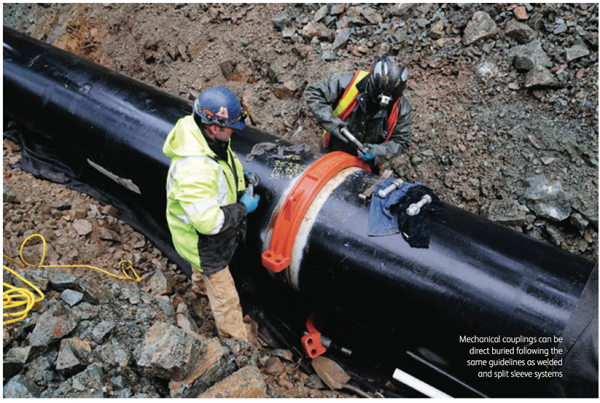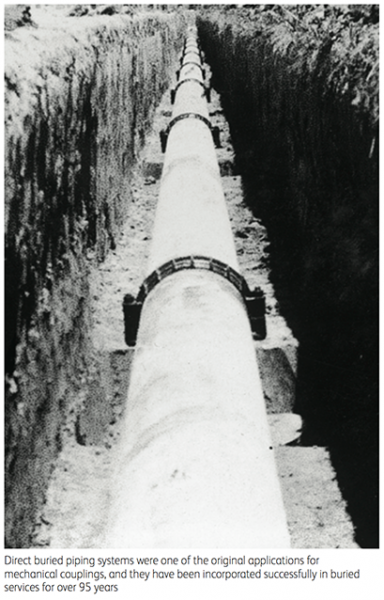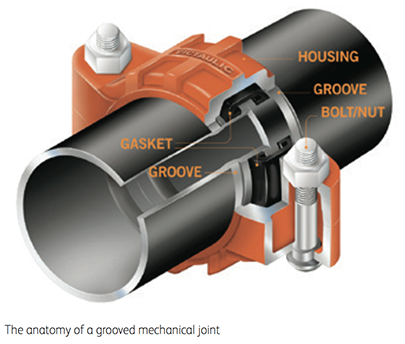Direct buried piping systems were one of the original applications for mechanical couplings and have been incorporated successfully in buried services for over 95 years. Simon Ouellette discusses buried pipework installation challenges and explains why mechanical joints are increasingly popular today for buried piping applications.


Simon Ouellette, Engineering Manager at Victaulic
Unpredictable conditions can make the outdoor installation of pipework more difficult. A full range of pipe-joining solutions can be used in buried piping, including welding, flanging and mechanical grooved systems, with all these offering different performance benefits and disadvantages.
While techniques have varied considerably over the years – flanging was employed by the Romans and mechanical pipe joining is a relatively recent 20th century development – pipe joining remains a critical area where choice of method can have a great impact on a project. Skill levels and ease and speed of operations are key factors that determine not only installation costs but also maintenance costs over time.
A traditional welded system requires highly skilled workers and is labour-intensive. To install and repair welded piping systems, workers have to cut out a damaged pipe section, which is time-consuming, can cause operational concerns and pose safety hazards.
In a traditional flanged system, multiple bolts are needed to create a joint, and adding and removing these bolts is a time-consuming process, as this must be done manually and there must be space around the joint for this operation to take place. For example, a 12-inch flange joint requires 12 bolts to be added or removed.
The grooved system
With mechanical pipe joints, typically only two bolts need to be removed to access the system, allowing more time-efficient maintenance procedures. Additionally, unlike a flanged joint, a two-bolt coupling can be “free floated” around the pipe for quick alignment adjustment and easy access. Mechanical pipe joining systems also require fewer installation man-hours than alternative methods.
Grooved mechanical pipe joining is a no-flame joining technique of forming or cutting a groove in pipe ends and then joining them with bolted housings around a sealed gasket. Since being made commercially available in 1919, it has become a preferred joining method on many piping applications, compared to welding, threading and flanging, and is commonly used in water systems technology projects.
A mechanical joint comprises four elements: grooved pipe, a gasket, coupling housings and a pair of nuts and bolts. The pipe groove is made by cold forming or machining a groove into the end of a pipe. The key section of the coupling housings engage the groove, and the bolts and nuts are tightened with a socket wrench or impact wrench, and hold the housings together.
The coupling housings engage in the groove around the circumference of the pipe and encase the gasket. A pressure-responsive gasket then creates a seal-unified joint that is enhanced when the system is pressurised.
For engineers, the benefits of the grooved system are many: The design versatility of the joint can allow both rigidity and flexibility throughout a system when necessary; a mechanical joint provides noise and vibration attenuation, seismic relief, and accommodates for thermal expansion and contraction. Added to these benefits, the system provides a union at every joint for ease of system maintenance and expansion.
Buried couplings
 Installing pipework outdoors can create numerous difficulties for engineers. Many problems may be caused by harsh external conditions, including the weather, difficult terrain, ground swell and landslides. Access to basic amenities is also often an issue. It is not always easy to bring a generator to remote areas in tough climatic conditions, whilst ensuring maximum safety levels are maintained. Delays are a common outcome.
Installing pipework outdoors can create numerous difficulties for engineers. Many problems may be caused by harsh external conditions, including the weather, difficult terrain, ground swell and landslides. Access to basic amenities is also often an issue. It is not always easy to bring a generator to remote areas in tough climatic conditions, whilst ensuring maximum safety levels are maintained. Delays are a common outcome.
Over a number of years, land may be subjected to ground movements and displacement, which can create stresses on pipes and even lead to underground breakages. This is very difficult for engineers to control. However, flexible couplings offer additional security, and can accommodate these potential misalignments without the need to install expensive and delicate specialised equipment.
The deflection characteristics of grooved systems offer significant benefits. They minimise the stresses that result from movement caused by ground and system thermal changes, settlement and seismic effects.
Flexibility must also be provided at ground breakthroughs to accommodate differential settlement of piping. None of these characteristics are simultaneously available in any other alternative joining technique, such as flanging, threading or welding.
In fact, mechanical couplings can be directly buried following the same guidelines as welded and split sleeve systems, and there are no special design considerations with respect to pipe and joint loading. Direct burial will not adversely affect joint performance or reliability. Mechanical joining systems provide a fully restrained pipe joint, while also allowing for flexibility at the joint.
Field advantages
Grooved systems help alleviate many of the other problems associated with using alternative joining methods in the field. Mechanical joints are perfect for outdoor, remote use, as they can be hand-assembled, obviate the need for power tools and can be mounted under any weather conditions, unlike welds, which need dry pipe.
Couplings provide visual confirmation of proper installation and there is no need for X-ray testing. With a union at every joint, they offer added flexibility and are more easily adjusted if alterations are needed.
Another benefit of using grooved mechanical piping systems is that their flame-free assembly reduces the risk of fire, as well as other hazards during installation. This is very important in outdoor installations, where the risk of using hotworks in dry conditions is high.
In addition, a trench carrying a flanged or welded pipe must be nearly twice the width of a trench carrying a grooved line, so using grooved technology lowers labour and time requirements, as well as the environmental impact.
At a recent penstock line installation in Canoe Creek, Canada, the use of the grooved system successfully narrowed the piping trench from 13 metres to six metres in the Pacific Rim Rainforest.
In other systems, such as District Heating, there is likely to be many hundreds of metres – sometimes kilometres – of pipework, which may include large-diameter pipe (350mm and above). Often, the pipe will be located in inaccessible trenches or buried, requiring solutions for accommodating thermal movement.
Whilst welding has traditionally been used to join pipework, on large projects with poor access, not only the welding operation itself but also the essential site preparation and the need to move welding equipment during the job will take considerable time.

Speed and ease
The speed of implementation is a very important factor, whether the project owner is a public agency or a private company. Grooved systems are dramatically faster than conventional solutions even in perfect construction conditions, lowering costs and limiting exposure to risk.
With measurable time savings between 35% and 50% compared to welding, grooved systems can contribute significantly to meeting tough deadlines. In harsh climatic conditions, the difference is even more impressive. Also, pipe misalignments during installation are easier to resolve, as angles can be changed more easily.
Maintenance is also much easier with grooved joints, which are easily maintained and easily expandable. It can take all day to unbolt a flanged joint depending on size. Compare this with only few minutes needed to unlock even a large-diameter grooved coupling.
Protection and corrosion
As with other alternative methods of joining pipe, the effects of soil conditions on buried systems must be incorporated into the system design to prevent corrosion. Special coatings and/or cathodic protection may be applied to ensure system longevity. Product applications and processes regarding direct burial and corrosion protection methods are not unique to pipe joints installed with mechanical couplings.
System designers should review ground soil conditions and make a determination of the appropriate coating for the application. On steel or iron piping systems, the same type of protection system used on the pipe may also be used for couplings.
While some grooved couplings are manufactured from ductile iron with zinc electroplated carbon steel hardware as a standard, coatings may also be applied in the field directly on to installed couplings.
External coverings, such as heat shrink tubing, tapes or wraps, mastics, wax and asphaltic tapes may also be applied directly over couplings. These coverings will provide the same corrosion protection as they do with other alternative joining methods, and can be installed in the same manner. For added corrosion protection, stainless steel bolting is an alternative to plated steel for buried applications.
Grounding and bonding
It is important for all pipe-joining methods that system designers follow good piping practices and ensure buried systems are adequately protected. Grounding of buried systems is necessary to ensure proper protection of a piping system from outside sources of electrical activity, such as lightning strikes, power line breaks and stray currents. Grounding is also necessary to ensure that static electricity within a pipeline does not build to a potentially dangerous level.
Stainless steel and bare steel direct buried systems are naturally grounded and do not require additional grounding. However, systems that incorporate coatings or wraps may need earthing along selected locations of the piping system.
Stainless steel, bare, painted, or galvanised grooved and bolted couplings, when installed on uncoated, galvanised or enamel-painted pipe ends will provide continuity across the pipe joint through the coupling housing.
This is important for systems that are grounded only at select locations, and where continuity across the pipe joints is required. Joint continuity is achieved by the high contact forces that occur between the coupling housings and the pipe in the area of the groove/restraint ring.
Similar to other joining methods, when the mating surfaces of either the pipe end or coupling are coated with something other than paint or galvanising prior to coupling installation, the use of grounding clips and/or grounding blocks will maintain continuity across the joint. It should be noted that in the event cathodic protection of the piping system is incorporated, the coupling housings must always be connected to the grounding method to ensure bonding of the coupling housing to the protected pipeline occurs.
Bonding of buried systems may be necessary to ensure electrical continuity through pipe joints and/or continuity with adjacent piping systems. Bonding is achieved by direct connection of the two materials to be bonded together through the use of jumper wires, continuity clips or some other means of providing continuity between the two materials.
Cathodic protection
 Cathodic protection is a technique used to control the corrosion of a material by making it the cathode of an electro-chemical cell. It is employed to protect a wide range of ferrous metallic equipment and structures in various environments, such as pipelines, ships, tanks, casings and offshore platforms.
Cathodic protection is a technique used to control the corrosion of a material by making it the cathode of an electro-chemical cell. It is employed to protect a wide range of ferrous metallic equipment and structures in various environments, such as pipelines, ships, tanks, casings and offshore platforms.
Cathodic protection of a piping system can be accomplished by several methods, the most common of which are the use of hot dip galvanising and high-zinc-content coatings. The zinc coats the carbon steel surface acting as a sacrificial anode preventing the corrosion of the underlying and surrounding material.
However, as with all sacrificial coatings, the coating will eventually become depleted and will no longer be able to protect the underlying material, typically carbon steel, from corrosion. Other methods of cathodic protection include the installation of zinc anodes directly on to the surface of the material to be protected or the use of zinc-rich corrosion-resistant paints and coatings.
In areas where pipeline integrity and longevity is required, and where pipeline integrity must be monitored, the use of imposed current cathodic protection can be applied. This method of protection utilises localised sacrificial anodes or remote anode beds along with an imposed current to ensure that corrosion protection is present even along the length of the pipeline. This method is often used in conjunction with pipeline coatings.
As with grounding, continuity of the pipeline is required to ensure the imposed current can freely travel the length of the protected area.
Couplings installed in an area protected by cathodic protection must be in direct contact or bonded to the pipe to ensure continuity through the connection and even protection of the joint. Continuity between the pipe and coupling is necessary to ensure the couplings do not experience accelerated corrosion.
Summary
Summing up the benefits, there is scope for significant financial savings by using mechanical grooved piping systems. Faster field installation, elimination of hotworks and reduced need for expansion joints all add up to advantages that are particularly important when choosing a system for a project in the current economic environment.
Selecting a high quality and innovative mechanical grooved piping system can bring improvements in productivity. In a sector where margins are increasingly tight, this is an attractive option for consultants, engineers and system designers alike.
The writer is the Engineering Manager at Victaulic. He can be contacted at simon.ouellette@victaulic.com
[div class=”row”]
[div class=”col-md-10 col-md-offset-1 content-sidebox”]
CPI Industry accepts no liability for the views or opinions expressed in this column, or for the consequences of any actions taken on the basis of the information provided here.
[end-div]
[end-div]
Copyright © 2006-2025 - CPI Industry. All rights reserved.